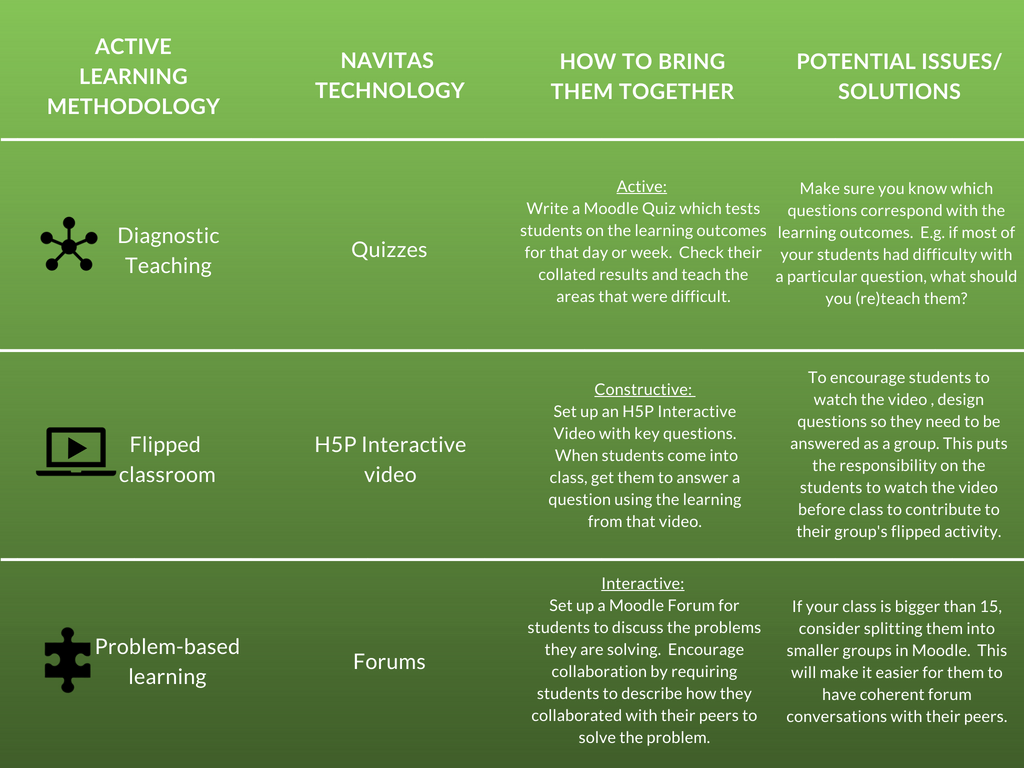Active learning: Matching methodology to technology

It’s an exciting time to be a teacher. There are mature methodologies for you to help your students utilise their new knowledge and enact their new skills – and students are hungry for them. Similarly, technological tools abound for you to help your class learn. Indeed, active learning and technology have a lot in common. They aim to involve students in the learning process and help the teacher individualise teaching for each specific cohort of students.
What is ‘active learning’?
Put simply (and somewhat reductively), active learning is “any instructional method that engages students in the learning process” (Prince, 2004, p.1). How are students engaged though? What observable behaviours should we expect from them and what do they mean for learning?
Dr Michelene Chi is an expert in this very subject and created the ICAP framework for differentiating learning activities. It divides student engagement into four types of externally observable behaviour: Interactive, Constructive, Active, Passive – listed in descending order for learning effectiveness.
Here’s Chi explaining the framework:
If you don’t have time for the video, here’s a basic breakdown:
- Passive engagement includes tasks like listening or reading (without taking notes)
- Active engagement includes taking notes or highlighting key phrases
- Constructive engagement could mean writing an essay or solving a problem (alone)
- Interactive engagement might mean solving a task with a tutor, or co-constructing knowledge with a peer
What are some common active learning methodologies?
There are many approaches to active learning, many of which you may already be using. Here are a few common ones which go beyond classroom techniques such as elicitation:
- Diagnostic Teaching (Cooper, 1977), and the related Teach-Test-Teach (TTT), involves some kind of diagnostic assessment to learn what your students know and what they need more help with. You then teach the students the areas they need rather than giving each aspect of the subject equal focus
- Flipped Classroom (Khan, 2011), involves getting students to learn the content at home before doing the interactive/creative (using ICAP) tasks in class – rather than as homework
- Problem-based learning (Barrows, 1996), occurs when students begin with a problem and learn through solving it, using a combination of self-directed learning and teacher guidance
What active learning technologies do we have at our disposal?
There are literally thousands of educational technologies out there. Here are three common ones which are also supported by Navitas Core Moodle:
- Quizzes, which are usually automatically marked and often multiple-choice.
- H5P Interactive Video, which are videos (usually YouTube) that have been ‘marked up’ with questions and notes to help learners understand where/when to focus.
- Forums, which are a great way to facilitate asynchronous discussion amongst a cohort.
The Navitas Technology Framework can help you consider additional ways you can bring active learning and technology into your teaching.
How can we bring them together?
This is where the magic happens – matching our methodology to technology, with an awareness of potential issues and solutions along the way.
As always when it comes to learning and teaching, this is just a start. If you would like more practical help and inspiration on integrating technology into teaching, join one of the upcoming Blended Learning Essentials courses or explore more on the Learning and Teaching at Navitas website.
To continue the conversation, contact Lindsay Rattray, or share your thoughts and ideas via Yammer, Twitter or LinkedIn.
References
- Barrows, H. S. (1996). Problem‐based learning in medicine and beyond: A brief overview. New directions for teaching and learning, 1996(68), 3-12.
- Chi, M. T., & Wylie, R. (2014). The ICAP framework: Linking cognitive engagement to active learning outcomes. Educational Psychologist, 49(4), 219-243.
- Cooper, K. (1977). Diagnostic teaching. Education 3-13, 5(1), 12-16.
- Khan, S. (2011). Salman Khan: Let’s use video to reinvent education. TED.
- Prince, M. (2004). Does active learning work? A review of the research. Journal of engineering education, 93(3), 223-231.

